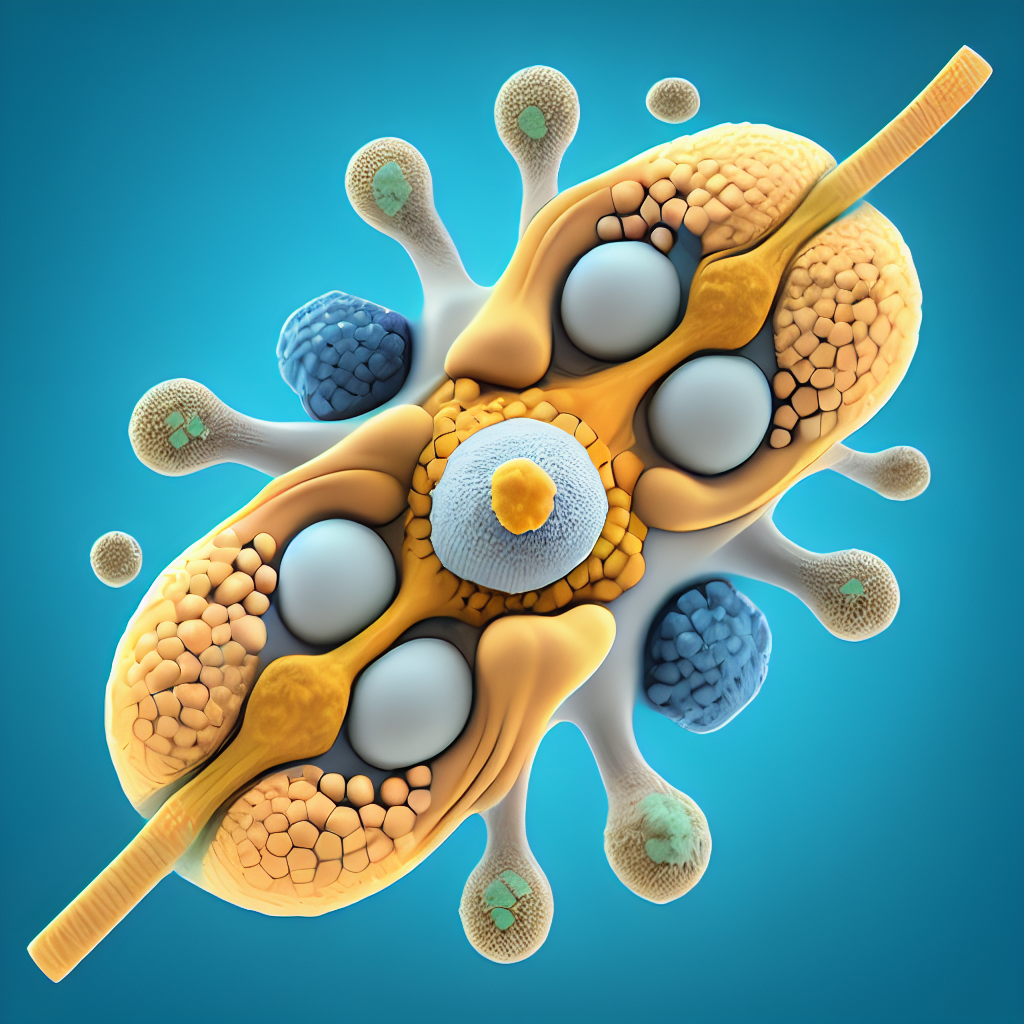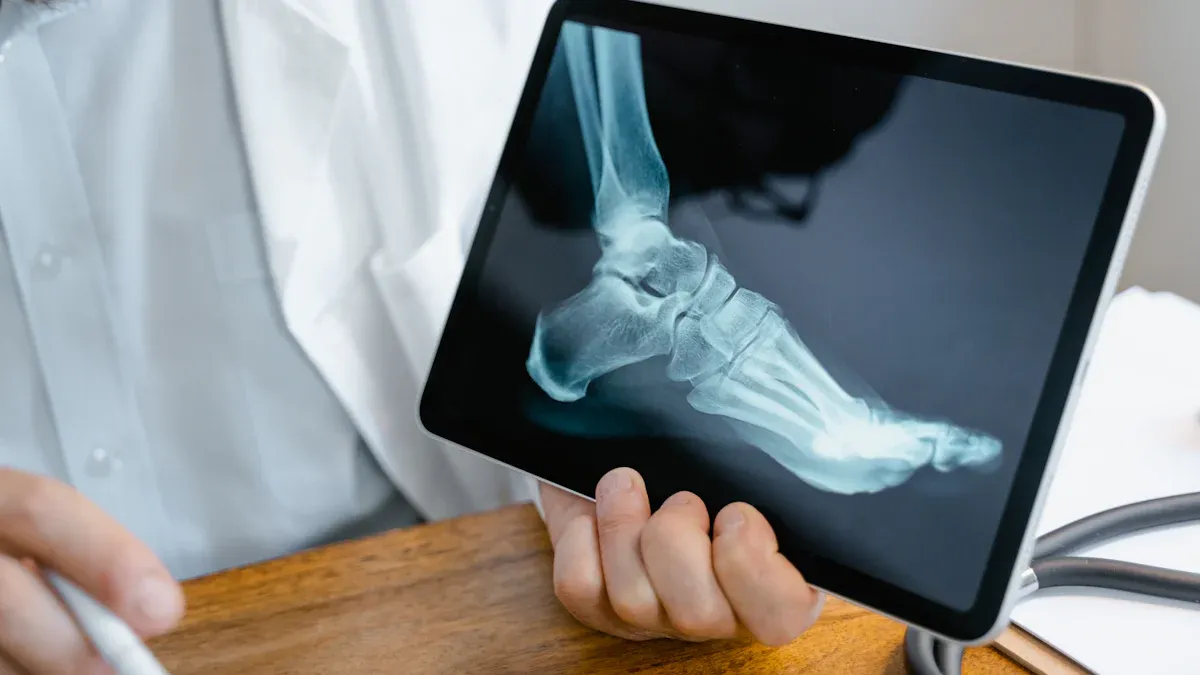What is Osteosarcoma and Its Symptoms

Osteosarcoma is a type of bone cancer that usually starts in the long bones of your arms or legs, often near the knee. It is relatively rare but affects about 1,000 people annually in the United States. Half of these cases occur in children and teens, making it the sixth most common cancer in individuals aged 0-19. Recognizing symptoms early can make a significant difference. Early diagnosis improves survival rates and ensures timely treatment, which can help prevent the cancer from spreading.
Did you know? Osteosarcoma accounts for about 2% of all childhood cancers.
Key Takeaways
Osteosarcoma is a rare and serious bone cancer. It mostly affects kids and teens aged 10-19. Finding it early helps with better treatment.
Main symptoms are constant bone pain, swelling, or lumps near bones. Broken bones without a clear reason can also be a sign. Watch for these, especially during growth spurts.
If you feel strong pain, see swelling, or notice movement changes, talk to a doctor right away. Finding it early can save lives.
Osteosarcoma can spread to other body parts. This may cause tiredness and weight loss. Spotting these signs early is very important.
Take care of your health by watching for symptoms. Visit a doctor quickly if needed. Acting early gives better chances for good treatment.
What is Osteosarcoma?
Definition and Overview
Osteosarcoma is a malignant bone tumor that develops from cells responsible for forming bones. It is the most common type of bone cancer in children and adolescents, though it can occur at any age. This cancer typically starts in the long bones, such as the femur (thighbone) or tibia (shinbone), near the knee or shoulder. Unlike other bone cancers, osteosarcoma originates from primitive mesenchymal cells that transform into osteoblasts, the cells that create new bone tissue.
Characteristic | Description |
|---|---|
Origin | Malignant primitive mesenchymal cells differentiating into osteoblasts. |
Common Locations | Typically occurs in the metaphyses of long bones, especially the distal femur, proximal tibia, and proximal humerus. |
Age Group | Most commonly affects children and adolescents, particularly those aged 10-19. |
Aggressiveness | Osteosarcoma is aggressive and often metastasizes to the lungs and other bones. |
Tumor Grade | Characterized by high-grade tumors that grow rapidly. |
This cancer is aggressive and often spreads to other parts of the body, such as the lungs, if not treated promptly. Early detection plays a crucial role in improving outcomes.
Commonly Affected Bones
Osteosarcoma primarily targets the metaphyseal regions of long bones. These areas, located near the ends of bones, are where growth occurs most actively during childhood and adolescence. The most common sites include:
The distal femur (lower part of the thighbone).
The proximal tibia (upper part of the shinbone).
The proximal humerus (upper arm bone near the shoulder).
The rapid growth in these regions makes them more susceptible to mutations that can lead to osteosarcoma. You may notice symptoms like pain or swelling in these areas, especially during periods of rapid growth.
Who is Most at Risk?
Osteosarcoma most often affects individuals between the ages of 10 and 30, with teenagers being the most vulnerable. Several factors increase the risk:
Factor | Description |
|---|---|
Age | Highest risk between ages 10 and 30, particularly during teenage growth spurts. |
Height | Children with osteosarcoma are usually tall for their age, indicating a link to rapid bone growth. |
Sex | More common in males; females may develop it slightly earlier due to earlier growth spurts. |
Race/Ethnicity | Slightly more common in African American, Hispanic, and Latino children than in White children. |
Previous Radiation Exposure | Higher risk for those treated with radiation therapy for another cancer, especially at younger ages. |
Bone Diseases | Certain non-cancerous bone diseases increase risk, such as Paget disease, particularly in older adults. |
Inherited Cancer Syndromes | Individuals with rare inherited cancer syndromes have an increased risk of developing osteosarcoma. |
If you or someone you know falls into these categories, staying vigilant about symptoms is essential. Early medical evaluation can make a significant difference.
Early Symptoms of Osteosarcoma

Persistent Bone Pain
One of the earliest signs of osteosarcoma is persistent pain in the affected bone. You may notice this pain worsening at night or during physical activity. It often starts as a dull ache but can become more severe over time. For children and adolescents, this pain might be mistaken for growing pains. However, if the discomfort does not improve or keeps getting worse, it could indicate a more serious issue. Pain at the tumor site is the most common symptom, and it may occur even when the bone is at rest or under minimal stress.
Swelling or Lump Near the Bone
Swelling or a noticeable lump near the affected bone is another early symptom. This lump may feel warm or tender to the touch. In some cases, redness may develop around the area, making it appear inflamed. You might also observe a difference in muscle size near the tumor site. For example, if the tumor is in the leg, the surrounding muscles may look smaller or weaker. These changes often occur later than the initial pain but should not be ignored. A lump or swelling that persists or grows larger over time warrants immediate medical attention.
Limited Movement or Limping
Osteosarcoma can affect your ability to move freely. If the tumor develops near a joint, it may limit the range of motion in that area. You might find it difficult to bend or straighten the affected limb. When the tumor is in the leg, limping or walking difficulties are common. These symptoms can interfere with daily activities, such as climbing stairs or playing sports. In severe cases, the weakened bone may fracture, causing sudden and intense pain. If you notice any of these signs, consult a healthcare professional promptly.
Tip: Pay close attention to persistent pain, swelling, or changes in movement, especially in children and teens during growth spurts. Early detection can make a significant difference in treatment outcomes.
Unexplained Fractures
Unexplained fractures can be an early warning sign of osteosarcoma. These fractures occur when a bone breaks unexpectedly, often with little or no trauma. You might notice this happening after a minor fall or even during routine activities like walking or climbing stairs. This happens because the tumor weakens the bone, making it more fragile and prone to breaking.
In many cases, the fracture occurs at the site of the tumor. For example, if the tumor is in the leg, you might experience a sudden break in the thighbone or shinbone. This can cause intense pain and swelling, making it difficult to move the affected limb. If you or someone you know experiences a fracture without a clear cause, it’s important to seek medical attention immediately.
You may also notice that the bone pain you’ve been feeling becomes much worse after the fracture. This pain often doesn’t go away with rest or over-the-counter pain relievers. While fractures can happen for many reasons, unexplained ones—especially in children or teens—should never be ignored. They could be a sign of an underlying condition like osteosarcoma.
Note: If you notice persistent pain, swelling, or a sudden fracture, consult a healthcare provider. Early diagnosis can make a significant difference in treatment outcomes.
By paying attention to these signs, you can help ensure that any potential issues are addressed promptly. Remember, unexplained fractures are not just accidents—they could be your body’s way of signaling a deeper problem.
Advanced Symptoms of Osteosarcoma
Severe and Persistent Pain
As osteosarcoma progresses, the pain in the affected bone becomes more severe and constant. You may notice that the pain worsens at night or during physical activity. Over time, this discomfort can interfere with daily tasks, making it difficult to focus or rest. The pain often originates at the tumor site and may spread to nearby areas. If the tumor is in a leg bone, walking or standing might become increasingly painful. This persistent pain is one of the most common advanced symptoms and should not be ignored.
Noticeable Swelling and Redness
Swelling around the tumor site becomes more pronounced as the disease advances. You might observe redness or warmth in the swollen area, which could indicate inflammation. In some cases, a lump or mass may develop, depending on the tumor's location. For example, if the tumor is near a joint, the swelling might limit your ability to move that joint. This symptom often appears later than the initial pain but serves as a clear sign that the condition is progressing. If you notice these changes, seek medical attention promptly.
Fatigue and Weight Loss
Advanced osteosarcoma can affect your overall energy levels and appetite. You may feel overwhelming fatigue, even after resting. This fatigue often accompanies unintended weight loss, as the body struggles to cope with the cancer's demands. Other systemic symptoms, such as fever or anemia, may also develop. These changes can make it harder to maintain your usual activities and may signal that the cancer has spread to other parts of the body. Paying attention to these signs can help ensure timely medical intervention.
Note: If you experience severe pain, noticeable swelling, or unexplained fatigue and weight loss, consult a healthcare provider immediately. Early action can improve treatment outcomes.
Symptoms of Metastasis
When osteosarcoma spreads to other parts of the body, it is known as metastasis. This stage often brings additional symptoms that can affect your overall health and quality of life. The lungs and bones are the most common sites where metastasis occurs. Recognizing these symptoms early can help you seek timely medical care.
Common Sites of Metastasis and Their Symptoms
Symptom/Organ Affected | Description |
|---|---|
Lung | Most common site for systemic metastasis |
Bones | Second most common site, often affected after lungs |
If the cancer spreads to the lungs, you might experience difficulty breathing, persistent coughing, or chest pain. When it spreads to other bones, you could notice new areas of bone pain, unexplained fractures, or difficulty walking if a leg bone is involved.
General Symptoms of Metastasis
Metastasis can also cause systemic symptoms that affect your entire body. These include:
Overwhelming fatigue
Unintended weight loss
Fever
Low red blood cell count (anemia)
Loss of bladder or bowel control (if the pelvic bone is affected)
These symptoms occur because the cancer disrupts normal body functions. For example, anemia can make you feel weak and tired due to a lack of oxygen in your blood. Fever may indicate your body is responding to the cancer's presence.
If you notice any of these symptoms, especially alongside persistent bone pain or swelling, consult a healthcare provider immediately. Early detection of metastasis can improve treatment options and outcomes.
Symptoms in Adults vs. Children

Differences in Symptom Presentation
Osteosarcoma symptoms can vary between adults and children. In children, the disease often presents with persistent bone pain, swelling, or a noticeable lump near the affected area. These symptoms may appear during growth spurts, making them easy to confuse with growing pains. You might also notice limping or difficulty moving a limb if the tumor is near a joint. Children tend to experience these symptoms earlier because their bones grow rapidly, which can accelerate tumor development.
In adults, the symptoms may develop more gradually. Bone pain might feel less intense at first, leading to delays in seeking medical attention. Swelling or lumps may also take longer to become noticeable. Adults are less likely to associate these symptoms with a serious condition, which can result in late-stage diagnoses. Additionally, unexplained fractures are more common in adults due to weakened bones from aging or other conditions. Paying attention to these subtle differences can help you recognize the signs earlier.
Tip: If you or your child experiences persistent bone pain or swelling, consult a healthcare provider without delay. Early detection improves treatment outcomes.
Why Osteosarcoma is More Common in Children
Osteosarcoma occurs more frequently in children and adolescents than in adults. This cancer accounts for over 50% of primary bone tumors, with 55% of cases affecting individuals aged 15 to 25. The rapid bone growth during puberty increases the likelihood of mutations that lead to tumor formation. Taller children, who often experience faster growth, may face a higher risk.
In adults, osteosarcoma is rare. The slower rate of bone growth reduces the chances of developing this cancer. However, adults with pre-existing bone conditions or a history of radiation exposure may still be at risk. Survival rates also differ significantly. Pediatric patients have a five-year survival rate of 78%, while elderly patients face a much lower rate of 25%. These statistics highlight the importance of early diagnosis, especially in younger individuals.
Note: Understanding why osteosarcoma affects children more often can help you stay vigilant during critical growth periods.
When to Seek Medical Attention
Recognizing Red Flags
You should pay close attention to persistent symptoms that could indicate osteosarcoma. Early signs like bone pain that worsens at night or during activity, swelling near a joint, or a noticeable lump should not be ignored. If you or your child experiences unexplained fractures or difficulty moving a limb, these could also be warning signs. Symptoms such as fatigue, weight loss, or redness around the affected area may suggest the condition is advancing. Recognizing these red flags early can prompt timely medical evaluation, which is critical for better outcomes.
Tip: Persistent bone pain that doesn’t improve with rest or over-the-counter medication is a key red flag. Don’t wait to consult a healthcare provider.
Importance of Early Diagnosis
Early diagnosis plays a vital role in improving survival rates for osteosarcoma. Patients diagnosed before the cancer spreads to other parts of the body often have better outcomes. For example, localized osteosarcoma responds more effectively to treatment than cases with early metastatic progression. Timely local control of the tumor, combined with chemotherapy, can significantly improve survival rates.
Finding | Description |
|---|---|
Early Diagnosis | Patients with localized osteosarcoma have better outcomes. |
Local Control | Timely treatment improves survival rates. |
Disease Progression | Localized cases fare better than those with early metastasis. |
By addressing symptoms early, you increase the chances of successful treatment and reduce the risk of complications.
What Happens During a Medical Evaluation
When you visit a doctor for suspected osteosarcoma, they will perform several diagnostic steps to confirm the condition. The process typically begins with a medical history review and a physical examination. Imaging tests like X-rays, MRIs, and CT scans help identify the tumor's location and size. Advanced imaging techniques, such as PET scans, may also be used to detect metastasis.
Common Diagnostic Steps:
Medical history and physical examination
Imaging tests: X-rays, MRI, CT scans, bone scans, and PET scans
Biopsy to confirm the diagnosis
Did you know? MRI scans provide detailed images that help doctors assess the tumor’s extent and its relationship to surrounding tissues, which is crucial for surgical planning.
If osteosarcoma is suspected, the doctor may recommend a biopsy. This involves removing a small sample of the tumor for laboratory analysis. These steps ensure an accurate diagnosis and guide the treatment plan.
Osteosarcoma presents with symptoms that demand your attention. Persistent bone pain, swelling, or unexplained fractures are key warning signs. You might also notice fatigue, weight loss, or difficulty moving a limb. These symptoms can worsen over time, making early detection critical.
Seeking medical advice promptly can improve outcomes. A healthcare provider will guide you through diagnosis and treatment, ensuring you receive the care you need. Remember, recognizing the signs early and consulting a professional could save lives. Stay vigilant and proactive about your health.
Note: Osteosarcoma treatment often involves a multidisciplinary team. Navigating this process can feel overwhelming, but support from family and healthcare providers can make a significant difference.
FAQ
What causes osteosarcoma?
Osteosarcoma develops due to genetic mutations in bone-forming cells. These mutations cause uncontrolled cell growth. While the exact cause remains unknown, rapid bone growth during puberty, inherited genetic conditions, or prior radiation exposure may increase your risk.
Can osteosarcoma spread to other parts of the body?
Yes, osteosarcoma can spread, most commonly to the lungs or other bones. This process, called metastasis, often leads to additional symptoms like breathing difficulties or new areas of bone pain. Early treatment reduces the risk of spreading.
How is osteosarcoma treated?
Treatment typically includes surgery to remove the tumor and chemotherapy to destroy cancer cells. In some cases, radiation therapy may also be used. Your doctor will create a personalized treatment plan based on the tumor's location and stage.
Is osteosarcoma curable?
Osteosarcoma is curable, especially when detected early. Localized cases have higher survival rates. Advances in treatment, including surgery and chemotherapy, have significantly improved outcomes. Early diagnosis plays a key role in successful recovery.
Can osteosarcoma return after treatment?
Yes, osteosarcoma can recur. Regular follow-up appointments and imaging tests help monitor for recurrence. If it returns, additional treatments like surgery or chemotherapy may be necessary. Staying vigilant about symptoms ensures timely intervention.
Tip: Keep up with follow-up care and report any new symptoms to your doctor immediately.
See Also
Understanding Chondrosarcoma: Key Symptoms To Watch For
Identifying Leiomyosarcoma: Symptoms You Should Not Ignore
Ewing's Sarcoma: Symptoms and Causes Explained Clearly
Liposarcoma Overview: Recognizing Its Symptoms Effectively
Kaposi Sarcoma: Understanding Symptoms and Their Implications
